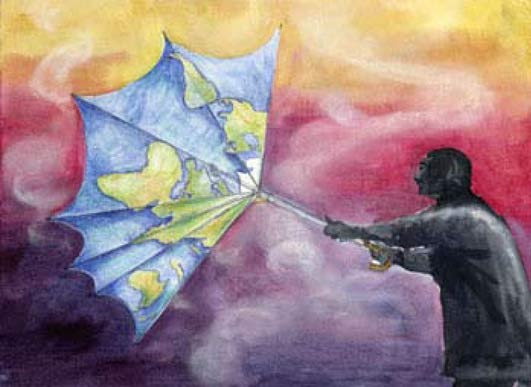 A faint rain drizzle earlier with near-balmy temperatures for the north coast of California this Thursday afternoon — altogether not unpleasant — but far, far to the west, mega-badass Super Typhoon Haiyan has clobbered the Philippine island of Samar, about 330 miles east of Manila.
A faint rain drizzle earlier with near-balmy temperatures for the north coast of California this Thursday afternoon — altogether not unpleasant — but far, far to the west, mega-badass Super Typhoon Haiyan has clobbered the Philippine island of Samar, about 330 miles east of Manila.
Supposedly, Haiyan made landfall with winds up to 195 mph, making it the biggest tropical typhoon on record to make landfall in all of history.
Dr. Jeff Masters at Wunderblog on the storm: Wind damage in Guiuan (population 47,000) must have been catastrophic, perhaps the greatest wind damage any city on Earth has endured from a tropical cyclone in the past century.
The typhoon is a horror. And after it bashes the Philippines, the storm will head straight for Vietnam and Laos, though, by then Haiyan should be down to a Cat. 3 typhoon. The Philippines has been seemingly a ground zero for what some regions on earth will experience/already-experiencing due to climate change.
From the Guardian in the wake of Super-Typhoon Bopha, which struck the southern Philippines in December 2012:
But more disturbing than Bopha’s size was the fact that it appeared to reflect rapidly deteriorating climatic trends.
The five most devastating typhoons recorded in the Philippines have occurred since 1990, affecting 23 million people. Four of the costliest typhoons anywhere occurred in same period, according to an Oxfam report.
What is more, Bopha hit an area where typhoons are all but unknown.
The inter-governmental panel on climate change says mean temperatures in the Philippines are rising by 0.14C per decade.
Since the 1980s, there has been an increase in annual mean rainfall.
Yet two of the severest droughts ever recorded occurred in 1991-92 and 1997-98.
Scientists are also registering steadily rising sea levels around the Philippines, and a falling water table.
All this appears to increase the likelihood and incidence of extreme weather events while adversely affecting food production and yields through land erosion and degradation, analysts say.
Mary Ann Lucille Sering, head of the Philippine government’s climate change commission, is in no doubt her country faces a deepening crisis that it can ill afford, financially and in human terms.
Typhoon-related costs in 2009, the year the commission was created, amounted to 2.9 percent of GDP, she said, and have been rising each year since then.
“Extreme weather is becoming more frequent, you could even call it the new normal,” Sering said.
“Last year one typhoon [Bopha] hurt us very much.
If this continues we are looking at a big drain on resources.”
Human activity-related “slow onset impacts” included over-fishing, over-dependence on certain crops, over-extraction of ground water, and an expanding population (the Philippines has about 95 million people and a median age of 23).
“Altogether this could eventually lead to disaster,” Sering said.
Unlike countries such as Britain, where changing weather has a marginal impact on most people’s lives, climate change in the Philippines was “like a war”.
Opinion surveys showed that Filipinos rated global warming as a bigger threat than rising food and fuel prices, she said.
The seemingly odd-ball character of climate change is one of its more-peculiar traits.
(Illustration found here).